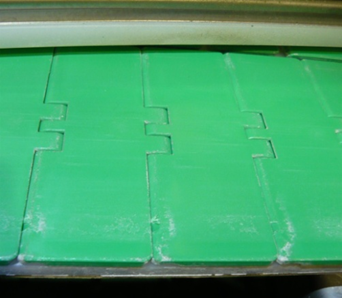| Cause 1 |
Chain may be hitting safety cover, frame, etc.


[Click to enlarge ]
|
Action |
Locate the source of the noise and make corrections so that the chain is not making contact. |
| Cause 2 |
Chain is running in a place where guide clearance with the wearstrip is tight. |
Action |
Locate the tight part, check for temperature-related expansion and/or deformation of the wearstrip, and make corrections. |
| Cause 3 |
Wearstrip surface finish is rough or dimensions and/or materials are inappropriate. |
Action |
Replace with wearstrip that has smooth surface finish, that is dimensionally accurate, or made from appropriate material. |
| Cause 4 |
Chain direction of travel is backward. |
Action |
Re-install chain. |
| Cause 5 |
Lubrication is inadequate or operating conditions are too extreme. |
Action |
Make changes in the lubricant and/or lubrication method. |
| Cause 1 |
The location and/or spacing of return rollers and/or size and/or position of the catenary curve are inappropriate.

[Click to enlarge ]
|
Action |
Refer to Engineering Manual of the catalog and correct so that the chain is running smoothly on return way. |
| Cause 2 |
Idler sprocket and/or return roller not spinning smoothly. |
Action |
Take corrective measures such as supporting by bearings or adopting return rollers of larger diameter. |
| Cause 3 |
Chain is running in a place where guide clearance with the wearstrip is tight. |
Action |
Locate the tight part, check for temperature-related expansion and/or deformation of the wearstrip, and make corrections. |
| Cause 4 |
Foreign matter adhering to the wearstrip is impeding smooth sliding. |
Action |
Clean wearstrip to remove foreign matter. |
| Cause 5 |
Chain is catching or snagging on obstructions and/or on sharp edges at the ends of wearstrips. |
Action |
Smooth out the sharp edges and remove obstructions. |
| Cause 6 |
Lubrication is inadequate or operating conditions are too extreme. |
Action |
Make changes in the lubricant and/or lubrication method. |
| Cause 1 |
Return rollers not rotating. |
Action |
Increase the diameter of return rollers or change their specifications. |
| Cause 2 |
Small return intake radius R, or diameter of return rollers is too small. |
Action |
Refer to Engineering Manual of the catalog and correct. |
| Cause 3 |
Rough surface finish and/or inappropriate material the wearstrip on return way. |
Action |
Correct layout so that wearstrip made of appropriate material with smooth surface finish makes uniform contact across the chain width. |
| Cause 4 |
Rough or gritty spots that promote friction are adhering to the return rollers or wearstrip. |
Action |
Clean the conveyor. Take measures to identify the cause. |
| Cause 5 |
Damages caused by gude rails and/or obstructions |
Action |
Identify the obstruction and make corrections. |
| Cause 1 |
Chain caught or snagged on foreign matter or obstruction. |
Action |
Remove foreign matter and obstructions. |
| Cause 2 |
Deterioration caused by chemicals or high temperatures, brittle fracture due to or corrosion. |
Action |
Identify cause and modify operating conditions or change the chain material. |
| Cause 3 |
Chain climbs sprocket teeth. |
Action |
Caused by excessive wear elongation of chain. Replace the chain. |
| Cause 4 |
Operating conditions too extreme and chain was subjected to catastrophic excess tension. |
Action |
Determine the cause and take corrective action. |
| Cause 5 |
Plug has fallen off. |
Action |
Check plug condition. Replace with new plug. |
| Cause 1 |
Excessive chain elongation. |
Action |
Replace chain and/or sprockets. |
| Cause 2 |
Foreign matter has accumulated on roots of sprocket teeth. |
Action |
Remove the foreign matter and clean. |
| Cause 3 |
Sprocket has shifted out of position or is misaligned. |
Action |
Re-install. |
| Cause 4 |
Defective sprocket (damaged, deformed, swollen, corroded). |
Action |
Investigate the cause and re-check specifications. Replace as needed. |
| Cause 5 |
Damage around the hub of split sprockets. |
Action |
Check for loose or over-tight sprocket bolts. Check that bolts have the proper tightening torque when replacing. |







